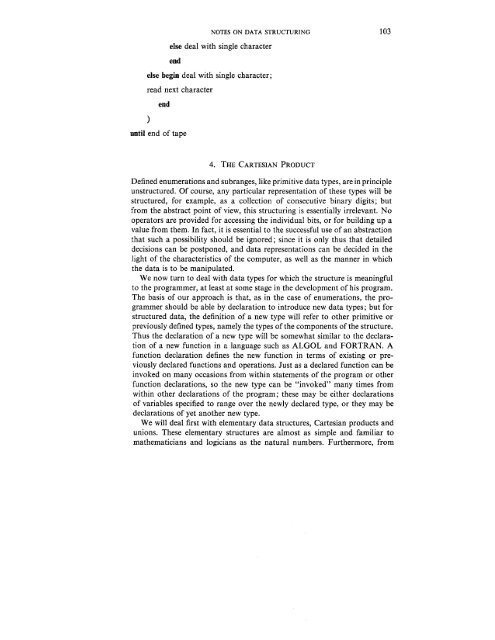II. Notes on Data Structuring * - Cornell University
II. Notes on Data Structuring * - Cornell University
II. Notes on Data Structuring * - Cornell University
Create successful ePaper yourself
Turn your PDF publications into a flip-book with our unique Google optimized e-Paper software.
NOTES ON DATA STRUCTURING 103<br />
else deal with single character<br />
end<br />
else begin deal with single character;<br />
read next character<br />
)<br />
end<br />
until end of tape<br />
4. THE CARTESIAN PRODUCT<br />
Defined enumerati<strong>on</strong>s and subranges, like primitive data types, are in principle<br />
unstructured. Of course, any particular representati<strong>on</strong> of these types will be<br />
structured, for example, as a collecti<strong>on</strong> of c<strong>on</strong>secutive binary digits; but<br />
from the abstract point of view, this structuring is essentially irrelevant. No<br />
operators are provided for accessing the individual bits, or for building up a<br />
value from them. In fact, it is essential to the successful use of an abstracti<strong>on</strong><br />
that such a possibility should be ignored; since it is <strong>on</strong>ly thus that detailed<br />
decisi<strong>on</strong>s can be postp<strong>on</strong>ed, and data representati<strong>on</strong>s can be decided in the<br />
light of the characteristics of the computer, as well as the manner in which<br />
the data is to be manipulated.<br />
We now turn to deal with data types for which the structure is meaningful<br />
to the programmer, at least at some stage in the development of his program.<br />
The basis of our approach is that, as in the case of enumerati<strong>on</strong>s, the pro-<br />
grammer should be able by declarati<strong>on</strong> to introduce new data types; but for<br />
structured data, the definiti<strong>on</strong> of a new type will refer to other primitive or<br />
previously defined types, namely the types of the comp<strong>on</strong>ents of the structure.<br />
Thus the declarati<strong>on</strong> of a new type will be somewhat similar to the declara-<br />
ti<strong>on</strong> of a new functi<strong>on</strong> in a language such as ALGOL and FORTRAN. A<br />
functi<strong>on</strong> declarati<strong>on</strong> defines the new functi<strong>on</strong> in terms of existing or pre-<br />
viously declared functi<strong>on</strong>s and operati<strong>on</strong>s. Just as a declared functi<strong>on</strong> can be<br />
invoked <strong>on</strong> many occasi<strong>on</strong>s from within statements of the program or other<br />
functi<strong>on</strong> declarati<strong>on</strong>s, so the new type can be "invoked" many times from<br />
within other declarati<strong>on</strong>s of the program; these may be either declarati<strong>on</strong>s<br />
of variables specified to range over the newly declared type, or they may be<br />
declarati<strong>on</strong>s of yet another new type.<br />
We will deal first with elementary data structures, Cartesian products and<br />
uni<strong>on</strong>s. These elementary structures are almost as simple and familiar to<br />
mathematicians and logicians as the natural numbers. Furthermore, from

















